By combining SmartHeat™, Connection Validation™ Soldering Systems, and the new CV-IOT Gateway, Metcal raises the bar on process control, giving manufacturers the ability to monitor and collect data on every joint being soldered in their operation.
Let’s not beat around the bush: It is now possible to collect data on every solder joint being made within an operation. The tip temperature, the tip geometry, the time it took to make the joint, and how many joints are being soldered per hour, day, month, or year.
It is possible to monitor all of this data live, in real-time, or collect it for further analysis later.
TOPICS COVERED
- SmartHeat™ + ConnectionValidation™ + CV-IOT = Complete Soldering Process Control
- CV-IOT Makes It Easy to Monitor and Collect Data from Every Soldering Station on Your Network
- Leverage More Data than Ever for Maximum Process Control and Traceability
Manufacturers can now oversee each station or an entire multi-location operation, virtually, from anywhere in the world.
This marks an incredible advance in hand soldering process control. Industry 4.0 and The Internet of Things have finally come to hand soldering.
Metcal has written the formula for bringing hand soldering into the 21st century, and it is the formula for maximum process control and traceability:
SmartHeat™ + ConnectionValidation™ + CV-IOT = Complete Soldering Process Control
Monitoring and collecting data on solder joints throughout an operation is the next logical step in Metcal’s advances in hand soldering. Patented Chip-in-Cartridge and ConnectionValidation™ technologies when combined with the new CV-IOT gateway module make collecting all this data possible and with it maximized process control.
SmartHeat™ Enables Consistent and Predictable Soldering Tip Temperatures
Part of process control is setting an optimal temperature for each solder joint being made. But how do you ensure those temperatures are being used by the operator? How can you avoid damaging sensitive components with unwanted overshooting of the soldering systems’ set temperature?
You use fixed-temperature soldering cartridges that cannot overshoot.
Metcal’s SmartHeat™ soldering cartridges are fixed temperature at the molecular level. By combining inductive heating and the characteristics of each metallic alloy’s Curry point, Metcal has created a set of cartridges in a full array of geometries that heat quickly, and apply heating Power-on-Demand, with little to no overshoot upon recovery.
For a full explanation of SmartHeat™, watch Metcal SmartHeat™: How Does It Work?
What this means in terms of process control is:
- Operators are locked into a specific temperature by the fixed-temperature cartridge.
- The temperature of that cartridge is predictable, consistent, and accurate, with no need to calibrate the system.
ConnectionValidation™ Technology Evaluates Each Joint as It Is Being Soldered
In 2017, Metcal introduced its breakthrough ConnectionValidation™ (CV) soldering systems. The CV system quickly and accurately evaluates each joint as it is being made via a multi-step process: Solder Event Detection, Preliminary Validation, Liquidus Detection, and Intermetallic Compound (IMC) Calculation. If the joint passes the validation process, the operator is alerted instantly with an audible alert and a visual alert right on the soldering handpiece.
ConnectionValidation™ is the best method available for evaluating solder joints at the benchtop, and it results in fewer faulting joints and improved joint consistency.
For more information on how ConnectionValidation™ works, watch the video below.
Along with ConnectionValidation™, the Metcal CV systems employ a patented Chip-in-cartridge technology. A small microchip in each heater cartridge passes information to the CV unit on the tip temperature rating, tip geometry, lot number, and more. The embedded chip allows managers to allow and restrict specific cartridges on each system and protects the system from non-conforming cartridges.
What this means for process control is:
- Each joint is validated at the benchtop as it is being soldered.
- The use of specific cartridges can be allowed or restricted by managers.
The New CV-IOT Module Allows for the Collection of All Soldering Data in a Centralized Database
Between SmartHeat™, the ConnectionValidation™ system, and the Chip-in-Cartridge technology, an immense amount of data is available on each solder joint.
If you were able to collect all that data from each system, that would mean a new level of process control for each station. And if you could collect all the data from every station in an organization, that would be unprecedented.
CV-IOT Module and Desktop Application Make It Easy to Monitor and Collect Data from Every Soldering Station on Your Network
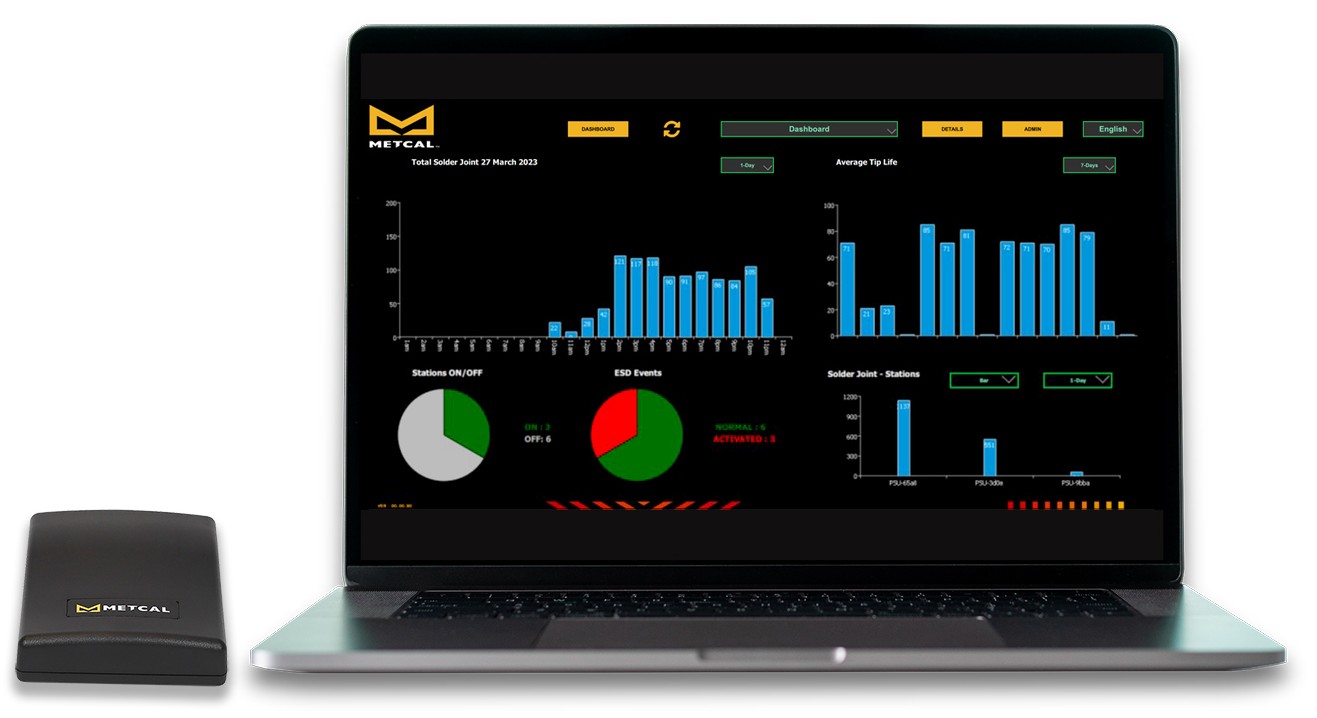
CV-IOT module and desktop application are simple to use, yet very comprehensive. Vital information to monitor during shifts is displayed on the Dashboard, with more details available as graphs or simple data sets.
The Dashboard Enables Live Monitoring of Your Entire Operation
The Dashboard screen displays:
- Total solder joints per day, week, month, 6 months, or year
- Average tip life per 7 days, 30 days, 90 days, or year
- Solder joints per station by day, week, month, 6 months, or year
- Number of stations on/off
- ESD events
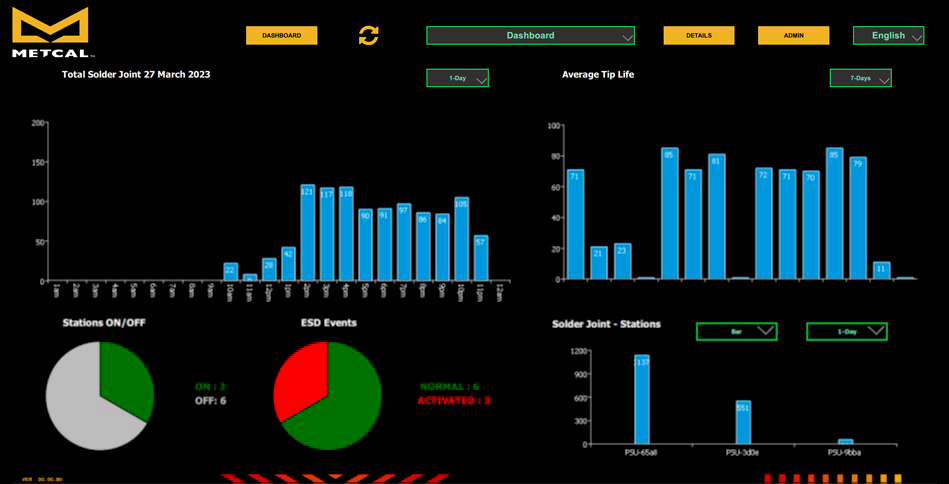
Figure 1 Dashboard Screen
Details Button Reveals Comprehensive Data on Every Solder Joint Made
Clicking the Details button takes the user to the main database and access to information on each solder joint:
- Timestamp
- Station name
- Station type (Lead or Lead-Free)
- IP Address
- MAC Address
- PCB number (the CV-IOT can be connected to a barcode scanner for added traceability)
- Cartridge part number
- Cartridge type
- Cartridge serial number
- Cartridge lot code
- Temperature scale (C/F)
- Station port used
- Joint count
- Idle temperature
- CV validation result
- Tip temperatures during solder event
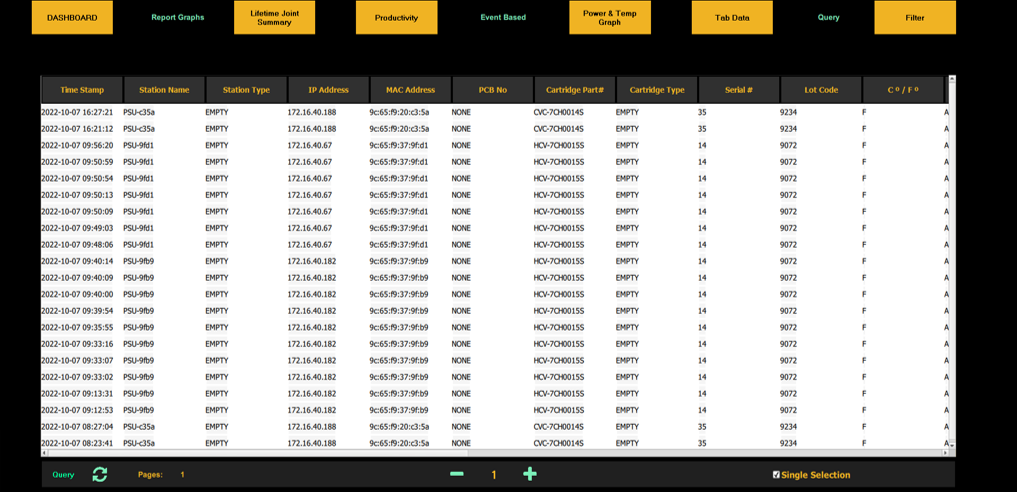
Figure 2 Details of each solder joint
Graphs Enable Greater Process Control at a Glance
There are also graphs for Lifetime Joint Summaries (Total, Pass, and Fail), Productivity by Month/Serial Number/This Year/Cartridge/Lot Code) and Power & Temperature graphs.
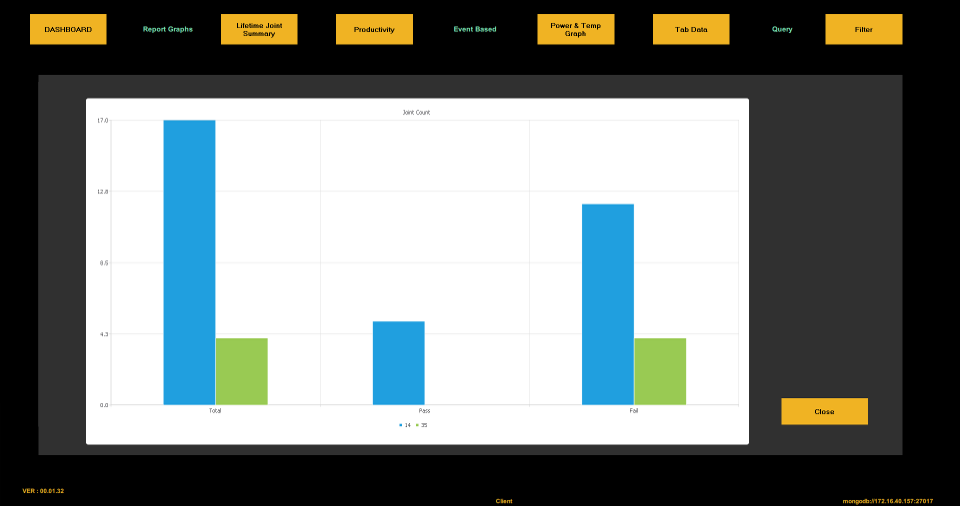
Figure 3 Lifetime Joint Summary Graph
Email Alerts Notify Managers of Unexpected Events
The CV-IOT software can easily be set up to send email alerts notifying managers of cartridge changes and ESD events. Future versions may also include alerts of power resets, joint rejection by the CV evaluation, handpiece disconnections, idle tip temperature fluctuations, and tip-life anomalies.
Exportable Data Provides Powerful Traceability
All data collected by the CV-IOT can be easily exported as a CSV file for further analysis in the application or system of your choice. Within the Admin area, managers can easily extract full databases to their hard drives or email them to the address of their choosing. The information is stored in a standard database structure to ensure maximum compatibility with Microsoft Excel and other spreadsheet applications.
Leverage More Data Than Ever for Maximum Process Control and Traceability
With information on every solder joint from every station, a new level of process control and traceability has opened for hand soldering operations:
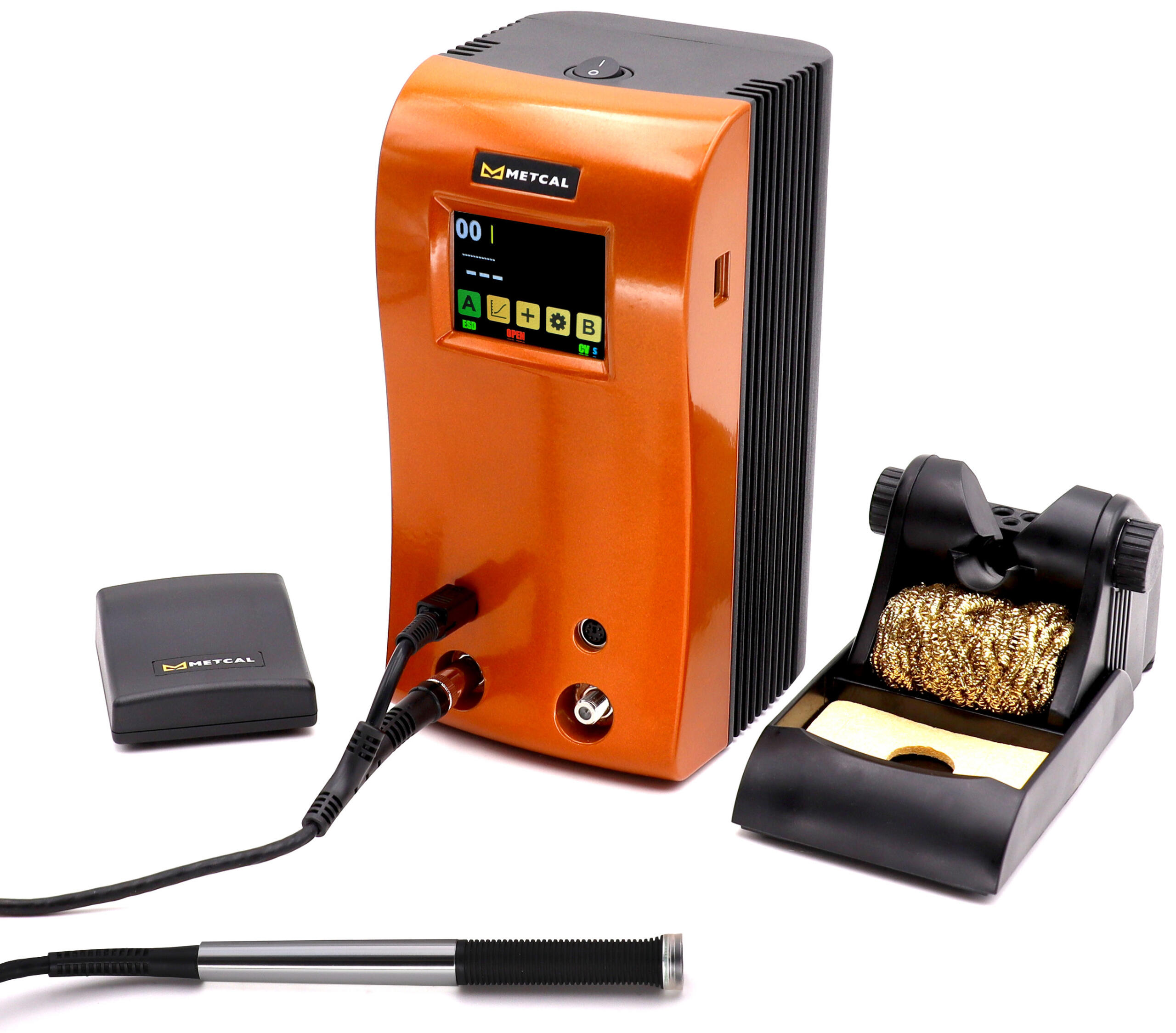
Process Control
- Monitor the tip geometry, soldering temperature, and power profile of each station
- Track the soldering process through automatic evaluation of each joint
- Quickly spot dips and spikes in productivity in real time
- Refine data views through filters and user configurations of the software application
- Receive email alerts of cartridge changes and ESD events
- Add board information with an optional handheld scanner
- Manage costs by comparing expected and actual tip life at each station
Traceability
- Review soldering statistics in the event of a board failure
- Find the root cause of faulty joints faster by analyzing data never before available
- Reveal where operators may need additional management or training
- Export all data to investigate issues using your own methodology
Learn how you can leverage the power of soldering data and CV-IOT by visiting Metcal.com, or by contacting us today to set up a demo. We are eager to answer any questions you might have about CV-IOT or any of our soldering, desoldering, rework, fume extraction, and fluid dispensing solutions.
Contact us about leveraging the power of CV-IOT

